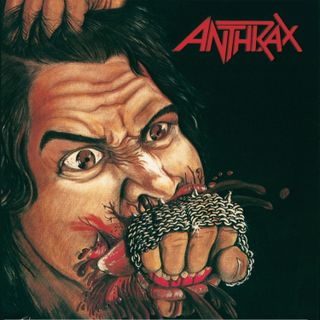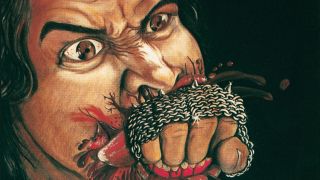By the time this first record from the New Yorkers hit, thrash was already starting to gather an irresistible momentum. Anthrax began in 1981, formed by school pals Scott Ian and Dan Lilker, both of whom played guitar in the very early days. The latter eventually switched to bass when they couldn’t find anyone suitable for the role. After the usual problems with getting a settled line-up, the band finally found a sense of purpose in 1983, with Ian and Lilker joined by lead guitarist Dan Spitz, vocalist Neil Turbin and drummer Charlie Benante. The five-piece recorded a five-track demo in early 1983, produced by Manowar guitarist Ross The Boss. Johnny Z, who ran the newly formed Megaforce label (they were about to release Metallica’s Kill ’Em All debut), heard it and signed them up.
“Actually, Charlie only appears on some tracks on that demo,” says Scott Ian. “He came in halfway through, with Greg D’Angelo (who later joined melodic hard rock stars White Lion) on the rest. The version of Soldiers Of Metal you hear on that demo, which does have Charlie was released as a single by Megaforce – our first commercial record. Howling Furies, with Greg, was on the B-side.”
The seven-inch single sold more than 3,000 copies in just two weeks, convincing everyone that Anthrax were on the march. Next stop: the debut album. And the band’s first problem was to nail down a producer. Ross The Boss had too many commitments with Manowar to be considered. For a time, Paul Curcio, who’d done Kill ’Em All, was in the frame. But he had to turn the project down, due to lack of time. So enter Carl Canedy… erm, who?
“Carl was the drummer with a great New York metal band at the time called The Rods,” explains the guitarist. “But I honestly really don’t remember why he produced us. I do know it wasn’t our choice though. I loved The Rods, however I never thought of Carl as a producer. All I can think is that he had spoken to Johnny Z at some point, and suggested he’d like to produce a few bands.”
Even with a producer now in place, Anthrax had to overcome a major problem before they could get in studio – and that was in finding somewhere suitable.
“We were gonna use Music America in Rochester, Upstate New York. We drove up there, only to find they’d taken out the old console, and the new one wasn’t yet in. Great! What a wasted journey. Why could nobody there have let us know?”
Canedy came up with a list of three possible options. The next day, Ian and Benante got in the car and drove to all three, before making their choice.
“We knew immediately Pyramid Studios in Ithaca was the one,” says Ian. “It felt right, and Alex Perialas – who owned the place – was a great guy. I reckon about half the albums released by Megaforce were done at Pyramid, and Alex produced a lot of these. The only drawback was the cost. It was the most expensive of the three, but Alex cut us a deal.”
The band, Canedy and engineer Chris Bubacz (who’d worked on Kill ’Em All as well) spent three weeks at the end of 1983 in Pyramid recording and mixing the album. The band were able to work quickly because they knew the songs so well.
Ian: “They were all written before we went into the studio, and a couple even went back as far as 1981. We were used to rehearsing them five nights a week. So, by the time we were in the studio, there was no wastage.”
- The story behind the song: I Am The Law by Anthrax
- Dave Mustaine and Scott Ian: ‘These new bands are spoilt motherf**kers’
- Anthrax’s Scott Ian takes us inside his insanely rare Stephen King collection
- Anthrax drummer Charlie Benante - The 10 Records That Changed My Life
The Anthrax dream was to make a record that combined Iron Maiden and Motörhead, their two primary influences at the time.
“We were all Maidenheads back then; we even had the Piece Of Mind album cover up in the studio. And I don’t think there’s a photo of me from that era where I wasn’t wearing a Motörhead t-shirt. If you listen to the album you can hear those influences – they come through so much.”
However, there was one song on the record that still causes Ian to shudder to this day, namely a cover of Alice Cooper’s I’m Eighteen. There’s a myth that it was the guitarist who chose this song for the band. Not so, he insists. “I love Alice Cooper, and that’s a classic song, obviously. But for Anthrax to do it… well, it was lame, cheesy and gay as far as we were concerned. Not one we should have done.
“I can’t remember who actually came up with the idea. I assume it was either Johnny or Carl. You see, at the time covers were getting metal bands radio airplay. Quiet Riot had just had a huge hit with Slade’s Cum On Feel The Noize, so everyone seemed to be doing something similar.”
Ian felt that, if the band were going to do a cover, then it should be more in keeping with their music and attitude.
“We did have some alternatives put forward, none of which I can now recall, but in the end I’m Eighteen won out. I suppose we could have considered doing a Motörhead or Maiden song, but they were still too fresh in the mind, really.”
Amazingly, Ian staged his own protest over the song’s inclusion – by refusing to play on the track.
“The rhythm guitar parts on that tracks are all played by Dan Spitz. I’m not on it at all. It was my way of making the point that we shouldn’t be doing such a song.”
While the recording process went comparatively smoothly, apart from Ian’s objections to the Cooper tune, the mixing stage was to be a problem, although at the time nobody realised what was happening.
“None of the band had a clue about studios, so we left everything to Carl. We were kids, what did we know? So, when we heard the mixes in the studio they sounded fine. The whole thing was very exciting. Then the album was sent away for mastering, came back and I heard the record for the first time out of the studio – and I was shocked. I recall saying to Johnny, ‘Where are the guitars? What’s happened to them?’. Carl had done the sort of mix that you might expect from a drummer. The drums were all turned up, and the guitars had been buried. I was really unhappy, and asked that we be allowed to re- mix it. But there was no budget for it.
“I’ve said for years that one day I am gonna re-mix the record, and get it right. That hasn’t happened yet, but it will.”
Fistful Of Metal was released in January 1984, coming out on the Music For Nations label in the UK. And, to everyone’s surprise, it sold really quickly.
“I was amazed that anyone had actually heard of us,” laughs Ian. “What I hadn’t taken into account was the tape-trading underground. There were so many people aware of Anthrax who had been waiting for that debut to come out.”
The album also caught the attention thanks to its rather violent cover, depicting a man being held down as a fist is thrust right through his mouth. Gory, gruesome… and very much in keeping with the metal philosophy. While Metallica never got the chance to do the cover they wanted for Kill ’Em All – a machete coming up through a toilet bowl – Anthrax went one stage further. But Ian is far from a fan of that artwork.
“It’s horrible, actually. It was Neil Turbin’s idea from start to finish, and was done by a guy called Kent Joshpe. But it’s also odd, because if you look at the two hands on the cover, they’re both left ones! The hand holding the guy’s head, and the other coming through his mouth – neither is a right hand.
“The one really good thing to come out of the sleeve was that we got a cool logo. Kent came up with several suggestions, and the one that stood out is what has been our logo ever since.”

From a distance of some 25 years, what does Ian make of Fistful Of Metal? It would appear that he still has reservations about the quality of the mix.
“I really can’t listen to it, because of the way Carl ended up mixing it. I have to say it’s been ruined for me, due to the way it sounds. I knew Carl was using some pretty strange effects in the studio, but having no experience at all, I wasn’t in any sort of position to argue with him. I love the songs on the record. Deathrider, Metal Thrashing Mad, Panic…they’re still excellent. It’s only the way they’re portrayed on the album that’s a problem for me.”
Nonetheless, for many Fistful Of Metal retains a certain cachet, being released just as thrash was starting to gather its formidable momentum. It immediately set Anthrax up as the masters of the East Coast thrash scene, and when you listen now to what was done, it’s raw, passionate, even savage in places. There’s little doubt that it has stood the test of time. In many ways what you hear is the sound of a band who never got the chance to develop their potential. Lilker and Turbin were gone very soon after Fistful Of Metal was released. However, their contributions are invaluable, and remain a crucial part of the Anthrax story. Scott Ian himself is the first to acknowledge what the record did for the band’s status.
“Let’s face it, Fistful Of Metal gave us our career. It got the band some attention, made people all over the world aware of what we could do – and for that reason alone I have to be grateful to everyone involved. The record was vital in launching us, and everything we’ve done, and become, since stems from that debut record.
“I may be critical of it in some ways, but I could never do anything other than admit we owe it all to Fistful Of Metal. If that had never happened… well, perhaps you would never have heard of Anthrax.”


